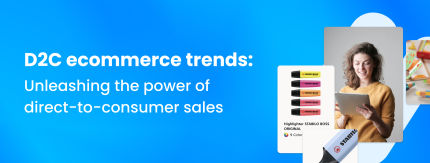
In the fast-paced and ever-evolving retail landscape of today, Direct-to-Consumer (D2C) ecommerce has emerged as a potent strategy for brands and businesses to directly sell their products to customers. This approach brings a multitude of benefits, including enhanced control over the customer experience, increased profit margins, and valuable access to customer data.
Driven by evolving consumer preferences and propelled by technological advancements, D2C sales have experienced exponential growth in recent years. In this discussion, we explore the key trends shaping the D2C ecommerce landscape and offer insights to help businesses thrive in this highly competitive environment. Additionally, we highlight the solutions offered by Shopware, a leading ecommerce platform that excels in seamless D2C implementation.
The rise of D2C ecommerce
D2C ecommerce has gained traction due to various factors that contribute to its rising popularity. First, it grants brands and businesses greater control over the customer experience, allowing them to curate personalized interactions from the moment of discovery to post-purchase support. And second, D2C sales enable brands and businesses to enjoy higher profit margins by eliminating the need for intermediaries, such as distributors or retailers.
This direct relationship with customers also provides access to valuable data insights, allowing brands and businesses to better understand their target audience and tailor their offerings accordingly.
Advantages for businesses and consumers
D2C ecommerce offers compelling advantages for both businesses and consumers.
Brands can offer products at lower prices due to the elimination of middlemen, resulting in cost savings on both sides.
Brands are able to provide more personalized experiences and product customization for consumers, resulting in higher sales and a better customer experience.
Customers can enjoy faster shipping and delivery times, since D2C brands often have more control over their supply chains.
D2C sales enable enhanced brand interaction, fostering a direct and meaningful connection between businesses and their customers.
5 D2C ecommerce trends
There are a few notable trends beginning to reshape D2C ecommerce, empowering businesses to thrive in a competitive landscape. From personalization and omnichannel selling, to sustainability and influencer marketing, these trends highlight evolving consumer demands.
By leveraging these trends, businesses can create compelling experiences and stay ahead in the D2C space. Let’s delve into these five D2C ecommerce trends reshaping retail's future.
1. Personalization and customer experience
The demand for personalized shopping experiences is on the rise, with consumers expecting tailored recommendations, personalized product suggestions, and relevant content. D2C brands can leverage customer data through data analytics and AI algorithms to understand customer preferences, browsing history, and purchase patterns. This data-driven approach enables them to deliver highly personalized experiences at scale.
Technology plays a crucial role in enhancing customer experiences, with examples including AI-powered chatbots for personalized assistance, virtual try-on tools for fashion products, and interactive product visualization. You can learn more about the best ecommerce personalization tools here.
2. Omnichannel selling and integrated shopping experiences
Adopting an omnichannel approach is crucial for D2C brands to provide a seamless and consistent shopping experience across various touchpoints. Integrating physical and digital channels allows customers to seamlessly transition between online and offline experiences.
Successful omnichannel strategies include in-store pickups for online orders, consistent branding across channels, mobile apps for a unified shopping experience, and personalized marketing messages across different touchpoints. See more on omnichannel strategies here.
3. Sustainability and ethical consumerism
Consumers are increasingly prioritizing sustainable and ethically sourced products. D2C brands can align with this trend by using recycled materials, implementing sustainable packaging solutions, sourcing from ethical suppliers, and reducing their carbon footprint.
Transparency and social responsibility are also crucial, as brands communicate their sustainability initiatives, share supply chain information, and support social causes to build trust and resonate with conscious consumers.
4. Social commerce and influencer marketing
Social media platforms have become powerful drivers of D2C sales. Brands can engage directly with their target audience and drive sales through platforms like Instagram, TikTok, and Pinterest.
Influencer marketing plays a vital role in leveraging social commerce, as brands collaborate with influencers to promote products, create authentic content, and tap into their dedicated followers.
Effective strategies involve creating compelling content, tracking ROI through affiliate links, establishing long-term partnerships with influencers, and utilizing user-generated content to amplify brand reach and engagement.
5. Subscription-based models and membership programs
The rise of subscription-based D2C models offers convenience and fosters long-term customer loyalty. By offering recurring services or product subscriptions, brands and businesses can benefit from predictable revenue streams, increased customer lifetime value, and opportunities for upselling and cross-selling.
Successful subscription-based D2C businesses include curated product boxes, personalized replenishment services, and granting access to exclusive content or perks for members.
Overcoming challenges in D2C ecommerce
Navigating the world of D2C ecommerce presents its fair share of challenges for businesses. However, these challenges also bring opportunities for growth and innovation. By addressing these challenges head-on, businesses can position themselves for success and unlock the full potential of D2C ecommerce.
1. Supply chain management
A well-managed supply chain is essential for D2C brands to ensure efficient inventory management, seamless order fulfillment, and timely delivery. Addressing challenges such as demand forecasting accuracy, optimizing inventory visibility, and managing logistics and last-mile delivery are key to meeting customer expectations.
2. Data privacy and security
In the era of data-driven business operations, data privacy and security are of paramount importance. D2C brands must prioritize safeguarding customer information, complying with data protection regulations, and maintaining trust.
Implementing secure payment gateways, encrypting customer data, conducting regular security audits, and transparently communicating privacy policies are best practices to ensure data privacy and security.
3. Competition and market saturation
The D2C ecommerce landscape is highly competitive, with established brands and emerging startups vying for market share. To stand out in a crowded market, D2C brands and businesses must differentiate themselves through unique value propositions, innovative marketing campaigns, superior customer service, and niche targeting. Building a strong brand identity and fostering customer loyalty are crucial for long-term success.
The future of D2C ecommerce
In the years to come, the D2C trend will be of utmost importance for brand manufacturers, prompting many to seek a fresh approach to ecommerce, with a focus on technology and strategy. Technology must not only enable, but also foster the flexible development of D2C business models. D2C represents more than just a passing trend or technological advancements, it’s the progression of effectively meeting the needs of today's consumers.
However, the future of D2C sales will be shaped by the emergence of cutting-edge technologies such as Artificial Intelligence (AI), Augmented Reality (AR), and Virtual Reality (VR), which will revolutionize customer experiences and enable hyper-personalization. Voice commerce will also ascend in prominence, as voice assistants become seamlessly integrated into daily life, even more so than we see today.

Wrap-up: partner with Shopware to accelerate your D2C ecommerce journey
In conclusion, the success of brands and businesses in the dynamic landscape of D2C ecommerce relies on embracing the evolution of the industry. By capitalizing on trends such as personalization, omnichannel selling, sustainability, social commerce, and subscription-based models, companies can create captivating experiences that resonate with customers and foster long-term loyalty. Overcoming challenges related to supply chain management, data privacy, and market saturation is crucial for sustained growth and differentiation in the highly competitive market.
Looking ahead, emerging technologies like Artificial Intelligence (AI), Augmented Reality (AR), Virtual Reality (VR), and voice commerce will continue to transform consumer interactions, presenting exciting opportunities for innovative businesses. To navigate this ever-changing landscape successfully, partnering with Shopware, a leading ecommerce platform, can provide the tools and support needed to accelerate your D2C ecommerce journey.
To learn more about how you can leverage these trends and maximize your D2C ecommerce potential, contact us today or request a personal product demo. Explore the vast opportunities that D2C ecommerce offers and stay ahead of the competition with Shopware as your trusted partner.










